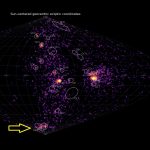C/2022 R2 is a recently discovered comet with a preliminary orbit that passes within 0.05 AU of Earth’s orbit. D criterion assessment suggests that this comet has the potential to lead to an annual radiant in the heart of Lepus around November 22nd to 24th.
Introduction
Today (20/09/2022) the Central Bureau for Astronomical Telegrams released a discovery notice inclusive of orbital elements for the newly discovered comet designated C/2022 R2 Atlas (Green & Nakano 2022). On the same day MPEC S87 was released containing astrometry from several sources (see MPC Staff, 2022) covering a roughly 5 day arc of this long period comet’s orbit.
Discussion
The current orbit is still somewhat preliminary but given no major changes going forwards this small Halley Type comet with a highly eccentric orbit will pass closest to Earth at roughly 1 Astronomical Unit (AU) on its way to a 0.628 AU perihelion on October 25th 2022 for the first time in around 220 years. The orbit is such that the comet’s ascending node lies within roughly 0.05 AU of the Earth’s orbit, and the comet was already at that point in during its September 14th 2022 discovery. The Earth itself will later pass the projection of this point around the 20th to 25th of November 2022. Given the current preliminary nature of the orbit all values are being expressed somewhat roughly.
A potential shower radiant’s particulars will be in the heart of Lepus near Right Ascension 84 degrees and Declination -20 degrees, the radiant should be active centred around Solar Longitude 240.2 degrees, or 19 hours on November 22nd 2022 UT, with the meteors being of medium speed with geocentric velocity of around 38 km/s.
However, as said, this comet is on a return to the inner Solar System for the first time in at least two centuries or so and although the comet did pass near Earth’s orbit before Earth itself it was still 1 AU from the Sun at that time and around five to six weeks prior to perihelion. In which case any particles ejected from the comet will not really have had enough time to cross the Earth orbit’s path. The same date in 2023 would give an extra year for such to occur.
Indeed, there are often predictions based on cometary orbits in the current era that do not come to pass and it may take many years for any meteoroids from this comet, if any at all, to hit the Earth’s atmosphere. On the other hand, the Southworth and Hawkins (1963) D criterion value for an Earth crossing shower is around 0.04 which in itself is promising given there being any actual meteoroids to be presented.
Examination of a collection of nearly two million meteor orbits of various derivation, both published and in the in the public domain, revealed only 7 candidates when seeded with the comet’s preliminary orbit for a period spanning from 2008 to 2021 inclusive, with none before then, some years providing none during that span, some years providing one, and, only 2021 providing 2 candidates. All of these could therefore be simply coincidental sporadics. Although given this is likely a small and indistinct comet, as it will never be much brighter than magnitude 15 at its best (barring any outbursts which would be occurring after the nodal passage thus therefore not likely to lead to any meteor activity before 2023 at the very earliest, with none guaranteed even then) it is possible that any meteoroids derivable from its last apparition are already long dispersed.
Meanwhile any potential 2022 activity at least has the rare decency to coincide with a virtually New Moon.
Conclusion
In the modern era potential meteor showers either freshly occurring due to or enhanced by comet passages can often be predicted. Whether they occur or not is another matter. C/2022 R2 has a preliminary 5 day arc orbit pointing to a potential of an annual meteor radiant with Solar Longitude 240.2 degrees emanating from the constellation of Lepus near 84 degrees Right Ascension and -20 degrees Declination, with a geocentric velocity of around 38 km/s.
Although the comet has already passed the point in its orbit closest to the Earth’s orbit both roughly five to six weeks prior to its perihelion and roughly nine to ten weeks before the Earth reaches that point in its own orbit, there is a chance for enhanced meteor activity in Lepus around November 22nd to 23rd (add one to each date for leap years) from 2022 onwards. Current meteor orbit datasets suggest that there is currently no real activity in the heart of this constellation at around that time.
Any activity would be likely to be picked up during current multistation meteor surveys as a matter of routine, given sufficient brightness.
Acknowledgement
This research has made use of data and/or services provided by the International Astronomical Union’s Minor Planet Center.
References
Green W. E., Nakano, S. (2022), “COMET C/2022 R2 (ATLAS)”.
http://www.cbat.eps.harvard.edu/iau/cbet/005100/CBET005171.txt
Jopek T. J. (1993). “Remarks on the meteor orbital similarity D-criterion”. Icarus, 106, 603–607.
MPC Staff (2022) “COMET C/2022 R2 (ATLAS)”.






